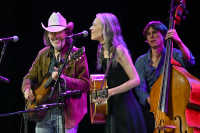According to some, Onegin is the ultimate expression of John Cranko’s choreographic and theatrical genius.
According to some, Onegin is the ultimate expression of John Cranko’s choreographic and theatrical genius. I disagree, for I think that other works are a much better testament to his unique creativity. But I like Onegin because it is one of those works in which choreography and acting go seamlessly hand in hand, thus creating a tension that makes one overlook and forgive much of the poor choreography — of which there is a good handful. That, though, is only when things work as they should. When they do not, the outcome can be dreary, like the performance I saw on the opening night of the new Royal Ballet season.
The company looked tired, unrehearsed and never much involved in the ongoing drama; not to mention the number of small and annoying accidents that marred the first two acts. Although Johan Kobborg and Alina Cojocaru are acclaimed interpreters of Onegin and Tatiana, their first two duets lacked dramatic vibrancy and showed little of the perfect partnership many remember so fondly. Steven McRae, as Lensky, looked just fine, but did not shine as he normally does. He is an ideal Lensky, for he seems to have come straight out of a Romantic painting, but in the well-known solo in Act II he did not project in full the desperation of a young man who is going to die. Cranko had set specific instructions and tempi for the various movements, to achieve a spine-chilling emotional effect. Alas, none of those well-preserved directions seems to have been taken into account. Next to him, Akane Takada, as Olga, indulged in a purely technical display of bravura that detracted greatly from the dramatic depths of her part.
Luckily, things improved considerably in the last act. The final duet, in which Tatiana overcomes her youthful longings and rejects Onegin, brought the house down and showed Cojocaru and Kobborg at their best. I think that the blame ought to fall on those who restaged it so carelessly, overlooking the subtleties of that central interaction between dance and drama mentioned above. If you want to see what a good Onegin should look like — that is, in stylistic and dramatic terms — just go on YouTube and see the recent breathtaking performance of the Paris Opera Ballet, with the new sensation Mathias Heymann as Lensky.
Earlier in the week, Russell Maliphant presented a revised and extended version of Afterlight, the superb solo he created last year for the Inspired by Diaghilev programme at Sadler’s Wells. Central to the work are the drawings that the legendary Nijinsky drew while under mental care. Nijinsky’s somewhat obsessive circular lines inform the rotating choreographic motifs first expounded in the solo and then developed in the following sections. In each part, the dancers’ action is constantly circumscribed by lighting designs (by Michael Hulls) and animation effects (by Jan Urbanowski and James Chorley),which illustrate the claustrophobic constraints of Nijinsky’s mental state.
Maliphant has also developed the first solo’s use of quotations in the new sections, referring more or less indirectly to dance images from Nijinsky’s time. Yet those visual traces are never too overwhelming, although some Isadora Duncan-like ideas in the second section could have been dealt with more subtly. Quotations appear also in Andy Cowton’s music for the new parts, creating a subtle game of references, with the solo set to Satie’s Gnossiennes 1-4. At just under an hour, the whole work sometimes looks overstretched, even though the performances of David Proietto, Silvina Cortés and Olga Cobos captivate the viewer with their sheer beauty and intensity.





Comments